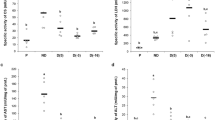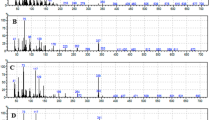Abstract
IN the course of biochemical studies1 on the embryonic diapause of the Bombyx silkworm, it has been shown that the glycogen content of the egg decreases markedly at the onset of diapause and reaches the lowest level at about thirty days after oviposition. When diapause is broken by cold treatment, glycogen increases progressively even at low temperature and regains the initial level almost completely. Pursuing the fate of glycogen during the diapause period, I have found that it is not consumed as an energy source, but it is converted to other substances including the following: sugars and their polymers, fat, lactic acid, gluconic acid and other organic acids such as Krebs cycle members, phosphoric esters and amino-acids.
This is a preview of subscription content, access via your institution
Access options
Subscribe to this journal
Receive 51 print issues and online access
$199.00 per year
only $3.90 per issue
Buy this article
- Purchase on Springer Link
- Instant access to full article PDF
Prices may be subject to local taxes which are calculated during checkout
Similar content being viewed by others
References
Chino, H., Embryologia (in the press).
Lambert, Marguerite, and Neish, A. C., Can. J. Research, 28B, 83 (1950). Cited in “Methods of Biochemical Analysis”, 3 (Interscience Pub., N.Y., 1956).
Author information
Authors and Affiliations
Rights and permissions
About this article
Cite this article
CHINO, H. Conversion of Glycogen to Sorbitol and Glycerol in the Diapause Egg of the Bombyx Silkworm. Nature 180, 606–607 (1957). https://doi.org/10.1038/180606b0
Issue Date:
DOI: https://doi.org/10.1038/180606b0
This article is cited by
-
Insect resilience: unraveling responses and adaptations to cold temperatures
Journal of Pest Science (2024)
-
The role of cancer cell bioenergetics in dormancy and drug resistance
Cancer and Metastasis Reviews (2023)
-
Genome wide gene-expression analysis of facultative reproductive diapause in the two-spotted spider mite Tetranychus urticae
BMC Genomics (2013)
-
How insects survive the cold: molecular mechanisms—a review
Journal of Comparative Physiology B (2008)
-
The regulation of trehalose metabolism in insects
Experientia (1996)
Comments
By submitting a comment you agree to abide by our Terms and Community Guidelines. If you find something abusive or that does not comply with our terms or guidelines please flag it as inappropriate.



